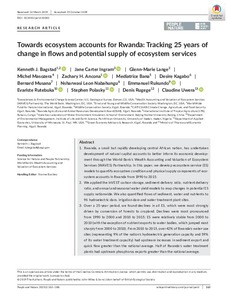| dc.contributor.author | Bagstad, K.J. |
| dc.contributor.author | Ingram, J.C. |
| dc.contributor.author | Lange, G. |
| dc.contributor.author | Masozera, M. |
| dc.contributor.author | Ancona, Z.H. |
| dc.contributor.author | Bana, M. |
| dc.contributor.author | Kagabo, D. |
| dc.contributor.author | Musana, B. |
| dc.contributor.author | Nabahungu, N.L. |
| dc.contributor.author | Rukundo, E. |
| dc.contributor.author | Rutebuka, E. |
| dc.contributor.author | Polasky, S. |
| dc.contributor.author | Rugege, D. |
| dc.contributor.author | Uwera, C. |
| dc.date.accessioned | 2020-08-13T13:34:23Z |
| dc.date.available | 2020-08-13T13:34:23Z |
| dc.date.issued | 2019-12-09 |
| dc.identifier.citation | Bagstad, K.J., Ingram, J.C., Lange, G.M., Masozera, M., Ancona, Z.H., Bana, M., ... & Rutebuka, E. (2020). Towards ecosystem accounts for Rwanda: tracking 25 years of change in flows and potential supply of ecosystem services. People and Nature, 2(1), 163-188. |
| dc.identifier.issn | 2575-8314 |
| dc.identifier.uri | https://hdl.handle.net/20.500.12478/6931 |
| dc.description.abstract | Rwanda, a small but rapidly developing central African nation, has undertaken development of natural capital accounts to better inform its economic development through the World Bank's Wealth Accounting and Valuation of Ecosystem Services (WAVES) Partnership. In this paper, we develop ecosystem service (ES) models to quantify ecosystem condition and physical supply components of ecosystem accounts in Rwanda from 1990 to 2015.
We applied the InVEST carbon storage, sediment delivery ratio, nutrient delivery ratio, and annual and seasonal water yield models to map changes in potential ES supply nationwide. We also quantified flows of sediment, water and nutrients to 96 hydroelectric dam, irrigation dam and water treatment plant sites.
Over a 25‐year period, we found declines in all ES, which were most strongly driven by conversion of forests to cropland. Declines were most pronounced from 1990 to 2000 and 2010 to 2015; ES were relatively stable from 2000 to 2010 (with the exception of nutrient exports to water bodies, which jumped most sharply from 2000 to 2010). From 2010 to 2015, over 42% of Rwanda's water‐use sites (representing 9% of the nation's hydroelectric generation capacity and 59% of its water treatment capacity) had upstream increases in sediment export and quick flow greater than the national average. Half of Rwanda's water treatment plants had upstream phosphorus exports greater than the national average.
Our results quantify nation‐wide ES trends, their implications for key water‐dependent industries, and the importance of protected areas in safeguarding ES flows and potential supply in Rwanda. They also provide data that can be integrated with existing land, water and economic accounts for Rwanda, as well as a baseline to inform development strategies that better link economic and environmental goals. |
| dc.description.sponsorship | Science for Nature and People Partnership |
| dc.description.sponsorship | World Bank's Wealth Accounting |
| dc.description.sponsorship | Valuation of Ecosystem Services |
| dc.language.iso | en |
| dc.subject | Ecosystems |
| dc.subject | Accounting |
| dc.subject | Services |
| dc.subject | Agricultural Production |
| dc.subject | Rwanda |
| dc.subject | Ecosystem Services |
| dc.title | Towards ecosystem accounts for Rwanda: tracking 25 years of change in flows and potential supply of ecosystem services |
| dc.type | Journal Article |
| cg.contributor.crp | Roots, Tubers and Bananas |
| cg.contributor.affiliation | United States Geological Survey |
| cg.contributor.affiliation | Ernst and Young and Wildlife Conservation Society, Washington |
| cg.contributor.affiliation | Wealth Accounting and Valuation of Ecosystem Services, Washington |
| cg.contributor.affiliation | World Wide Fund for Nature International |
| cg.contributor.affiliation | CGIAR Research Program on Climate Change, Agriculture and Food Security |
| cg.contributor.affiliation | Rwanda Agriculture and Animal Resources Development Board |
| cg.contributor.affiliation | International Institute of Tropical Agriculture |
| cg.contributor.affiliation | Beijing Normal University |
| cg.contributor.affiliation | Pan-African University |
| cg.contributor.affiliation | University of Minnesota |
| cg.contributor.affiliation | Green Economy Advisory & Research, Kigali |
| cg.contributor.affiliation | Ministry of Finance and Economic Planning, Kigali |
| cg.coverage.region | Africa |
| cg.coverage.region | East Africa |
| cg.coverage.country | Rwanda |
| cg.coverage.hub | Central Africa Hub |
| cg.researchtheme | Natural Resource Management |
| cg.identifier.bibtexciteid | BAGSTAD:2020 |
| cg.authorship.types | CGIAR and developing country institute |
| cg.iitasubject | Aflatoxin |
| cg.iitasubject | Agronomy |
| cg.iitasubject | Natural Resource Management |
| cg.iitasubject | Socioeconomy |
| cg.journal | People and Nature |
| cg.notes | Open Access Journal |
| cg.accessibilitystatus | Open Access |
| cg.reviewstatus | Peer Review |
| cg.usagerightslicense | Creative Commons Attribution 4.0 (CC BY 0.0) |
| cg.targetaudience | Scientists |
| cg.identifier.doi | https://dx.doi.org/10.1002/pan3.10062 |
| cg.iitaauthor.identifier | Nsharwasi Nabahungu: 0000-0002-2104-3777 |

